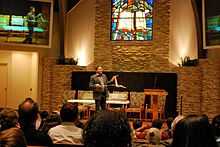Loma Linda University Center for Biodiversity and Conservation Studies
Loma Linda University Center for Biodiversity and Conservation Studies is an organization that was established by the Department of Earth and Biological Sciences at Loma Linda University in 2010. The organization seeks to enhance public awareness of the importance of environmental stewardship. Visitors are able to view live animals representing various biodiversity hotspots around the world. Reflecting Loma Linda University's Christian philosophy, the center especially seeks to increase environmental awareness among members of religious faith groups, where environmental concern often lags behind that of the general public.[1][2] While many praise the center for its efforts to encourage environmental stewardship, some have openly questioned whether it is an efficient way to effect real change.[3]

Current status
Currently, the center operates out of Mortensen and Griggs Halls on the Loma Linda University campus. Visitors are encouraged to tour the center's venomous snake exhibits, marine animals exhibit, and arthropod collection. The facilities house the venomous snakes, scorpions, spiders, centipedes, and endangered Caribbean boas currently being studied by Loma Linda University Earth and Biological Sciences researchers. The collections also include numerous animals featured in the center's educational programs such as gila monsters, crocodilians, sharks, and rays. Visitors may also tour the department's biology and geology labs to observe the research that students and faculty are currently conducting in areas such as marine biology, herpetology, avian ecology, venom use and variation, limnogeology, sedimentology, and taphonomy.[4] A portion of nearby Risley Hall is being remodeled into a new marine biology facility. When completed, the facilities will provide new wet laboratory space, student offices and a dedicated tide pool area for marine invertebrate physiological and behavioral studies. The center presents public nature shows, coordinates presentations by guest speakers, and offers field trips to both local and out of state destinations of interest.[5]
Future plans
In 2010, renovation began on a small 2,100sf building on the LLU campus where the center's animal collection was to be put on public display. Work came to a halt, however, when it was determined that the cost of necessary improvements could not be justified because the building is scheduled to be demolished within the next several years as a part of the university's master plan. Other concerns such as extremely limited parking contributed to the decision. In early 2012, an alternative site was located which offers several key advantages over other locations. A facility for lease just minutes from campus offers 44,000 square feet, 500+ parking spaces, convenient access to two major freeways, and a very competitive lease rate. The additional space would facilitate larger and more elaborate exhibits. Efforts are currently underway to secure the necessary funding as well as university and city approval to move ahead with acquisition. Current plans include Californian, Caribbean, South/Central American, African, Pacific Island and Australian/Asian biodiversity hotspot exhibits. Also planned are a shark tank, walk-through aquarium, interactive tide pool, bat cave, ancient environments exhibit and fossil dig, "Discovery Zone" (featuring themed temporary exhibits), classrooms for public lectures and media presentations, and a veterinary clinic where visitors will be able to watch staff provide medical treatment to the animals. Viewers will also be able to watch biologists perform research tasks such as extractions of snake, spider, scorpion, centipede, and waterbug venom for biochemical analysis, and surgical placement of transmitters in snakes for radio-telemetry studies. A key goal of the center will be to emphasize the many ways biodiversity contributes to human health and well-being. In keeping with the university's mission, "To Make Man Whole," the center will highlight ways ecological research is benefiting humans directly. It is hoped that the center will foster a spirit of environmental stewardship in the Inland Empire, which represents the 13th largest metropolitan area in the nation and is the only one of the top 30 to not have at least one major public zoo or aquarium. [6]
References
- ↑ Adventist Review : 12CN: LLU Opens Center for Biodiversity and Conservation Studies
- ↑ Hayes, F. E., and W. K. Hayes. In press. Seventh-day Adventist faith and environmental stewardship. In H. T. Goodwin (ed.), [book title not yet specified]. Andrews University Press, Berrien Springs, Michigan.
- ↑ Adventist Today : Salmonella is a Societal Disease?
- ↑ http://www.llu.edu/science-technology/ebs/index.page/
- ↑ Friends of Loma Linda University - View Content
- ↑ Loma Linda University Center for Biodiversity and Conservation Studies